Contents
Market Overview
Macro Review
An already tight labor market tightens further with U.S. unemployment declining to 3.6%. Nonfarm payrolls revealed another strong release even if it missed expectations, but the focus was still on government bonds. The 2-year U.S. Treasury rose 160 bps in the first quarter, reflecting its largest quarterly rise since 1984. This led to the U.S. 2s10s curve briefly inverting for the first time since August 2019 and June 2007, just as 5s10s, 7s10s and 5s30s remain inverted. Meanwhile, Germany’s 2-year bund turned positive, just as the country recorded annual inflation of 7.3%, which is the highest level since 1981. In contrast, the Bank of Japan has sought to limit the move in government bonds and began to buy an unlimited amount of the JGB 10-year as they defend the ‘yield curve control’ policy that effectively caps the 10-year at 0% within a 25 bps band, where the current benchmark bond is at 25 bps. Otherwise, the focus was on oil with brent down 13.3% on the week as the U.S. will release 180k barrels, after OPEC+ hiked output by 432k barrels from May. The SEC also added six additional Chinese entities to the HFCAA list on March 30, after adding five companies on March 10. As we highlighted in a previous EM Weekly, this is a provisional watch-list for delisting from U.S. exchanges but allows for three-years to fix auditing issues. Notwithstanding, the Nasdaq Golden Dragon Index was down 5.4% on Thursday. In addition, Chinese manufacturing PMIs came in weak at 49.5 with the Caixin PMI at 48.1, and MS responding and downgrading their 2022 growth forecast to 4.6% from 5.1%. Developments in Ukraine also saw the largest poultry producer (MHP) secure a 270-day extension to its grace period as it delays $51.5m in coupons until later in the year (2H coupons remain unchanged), which avoids a technical default. Additionally, the second largest thermal coal producer, SUEK, became Russia’s latest default after EuroChem and Severstal. SUEK has become Russia’s first inaugural issuer to not pay its first bond coupon as the instrument was issued as recently as last September.
EM Credit Update
Emerging market sovereign credit ended the week up 1.1% with spreads some 52 bps tighter. Outperformers over the week were Belarus, Russia and Ukraine, while Sri Lanka, Bolivia and El Salvador underperformed. The outperformers reflect a retracement after the significant widening in late February and early March. In addition, Russia and Belarus have been removed from the main EM indices at a cash price of zero, which has contributed to a recalibration of index spreads at a lower base.
The Week Ahead
The spotlight next week will be on the U.S. Supreme Court confirmation, along with FOMC minutes and the RBA decision. Within emerging markets, we can expect some noise around Hungarian elections before the focus shifts to Chinese FX reserves and money supply data. Of equal note, interest rate decisions are set for Hungary (6.15%), India (4.0%), Peru (4.0%), Poland (3.5%) and Romania (2.5%). Fedspeak from Lael Brainard on Wednesday covers inflation and could become an important indicator ahead of the May FOMC decision as the market moved to price in 38 bps. Finally, emerging market inflation releases are due out of Brazil, Chile, Colombia, Hungary, Mexico, Philippines, Thailand and Turkey.
Highlights from emerging markets discussed below include: Argentina EFF program receives IMF Board approval increasing net FX reserves by just over $6bn, Ceasefire in Ukraine does not appear imminent despite first substantive diplomatic engagement between the two sides since the start of hostilities, Ghana passes e-levy legislation to raise revenues by 1.5% of GDP, Peru’s President Castillo survives impeachment motion and Global emerging markets corporates in focus – more on Russia’s isolation.
Fixed Income
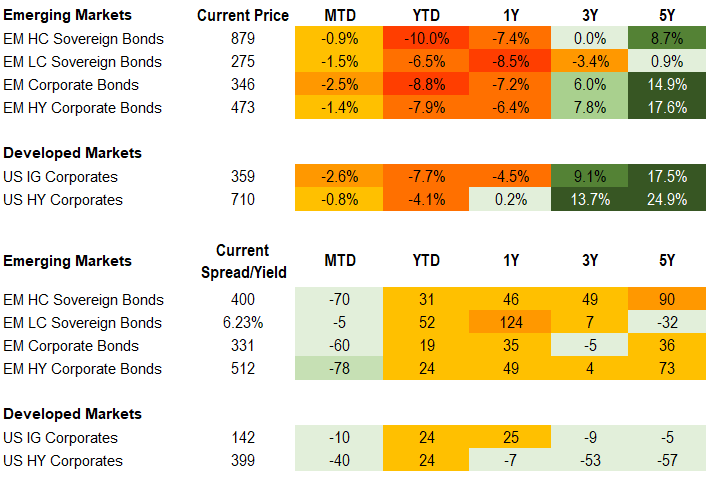
Equities
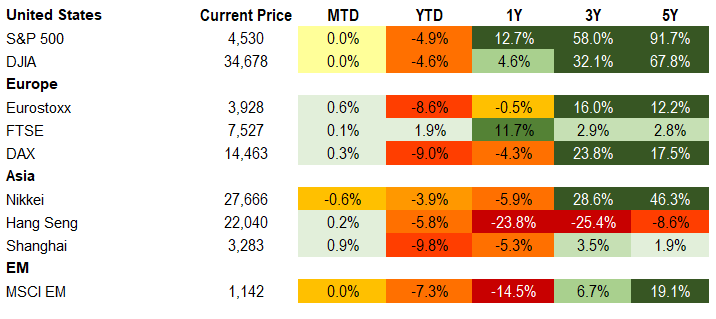
Commodities

Source for data tables: Bloomberg, JPMorgan, Gramercy. EM Fixed Income is represented by the following JPMorgan Indicies: EMBI Global, GBI-EM Global Diversified, CEMBI Broad Diversified and CEMBI Broad High Yield. DM Fixed Income is represented by the JPMorgan JULI Total Return Index and Domestic High Yield Index. Fixed Income, Equity and Commodity data is as of April 1, 2022 (mid-afternoon).
Emerging Markets Weekly Highlights
Argentina EFF program receives IMF Board approval increasing net FX reserves by just over $6bn
Event: After market close last Friday, the IMF published its press release on Board level approval of Argentina’s new $44bn EFF facility along with the full staff-level report. This coincided with a $9.6bn disbursement, of which just over $6bn will replenish net FX reserves. Fiscal and monetary performance criteria include targets for the primary balance, arrears, FX reserves, and Central Bank financing with just over 2% of GDP worth of fiscal consolidation and $15bn in FX reserve gains through 2024. The first review is scheduled for mid-2Q.
Gramercy Commentary: Finalization of the program limits downside policy risks and boosts near-term net FX reserves. The improved sentiment combined with an incrementally faster crawling peg should help to continue to compress the gap between the parallel and official FX rates which is now just above 70% compared to over 120% earlier this year. Argentine sovereign bonds have also come-off of their lows with upward momentum amid program execution and further disbursements. Our base case is for general program compliance with room for surmountable slippage which should continue to reduce near-term macroeconomic vulnerabilities and shift investor focus onto the political roadmap to the 2023 presidential election where an opposition victory and/or revamped political alliances could materially improve governability and policy.
Ceasefire in Ukraine does not appear imminent despite first substantive diplomatic engagement between the two sides since the start of hostilities
Event: Ukrainian and Russian delegations held two days of face-to-face exploratory peace talks in Istanbul this week, with Turkish president Erdogan serving as mediator. Meanwhile, fighting continues with Ukrainian forces recapturing territory around Kyiv, while the Russian assault appears to be increasingly focused on Donbas and the Black Sea coast, amid heavy losses sustained by the invaders.
Gramercy Commentary: The meetings in Turkey this week represented the first substantive attempt by the two sides to seek a negotiated end to the conflict that has entered its sixth week. However, the two sides remain far apart over what appears to be the most critical issues, namely the future status of Crimea and Donbas. As we wrote last week, the overall stalemate on the ground and Russia’s failure to achieve President Putin’s main objectives dim the prospects for a negotiated end of the conflict in the near future. Despite major military setbacks on Ukrainian soil, Kremlin’s goals appear to remain quite maximalist and involve demands that Kyiv formally recognizes Crimea as part of the Russian Federation as well as the independence of DNR and LNR, the two separatist territories in Eastern Ukraine. The Zelenskyy administration has signaled flexibility around the issues of “neutrality” and committing not to seek NATO membership in exchange for firm security guarantees for Ukraine by Russia and a group of regional and global powers, but remains resolute in its position not to cede “an inch of Ukrainian territory”. In this context, we expect diplomatic efforts in search for an acceptable “middle ground” to remain ongoing, but with limited prospects for significant de-escalation and ceasefire in the near-term. A potential direct meeting between presidents Zelenskyy and Putin, if it materializes, would be a major development in the direction of finding a resolution. As such, it is the key signpost that we are watching for and would likely signal that the two sides have reached readiness to compromise on the thorniest issues.
Ghana passes e-levy legislation to raise revenues by 1.5% of GDP
Event: The government reached political compromise and obtained parliamentary approval of the electronic transfer levy this week after lingering uncertainty over its viability. The tax is estimated to generate 1.5% of GDP of new revenues, down from the initial estimate of 1.75% of GDP.
Gramercy Commentary: The development is credit and market positive for the sovereign as it improves prospects for fiscal consolidation, the crux of Ghana’s vulnerabilities. While revenue measures often disappoint, failure to pass the levy would have lowered expectations further on the government’s ability to reach its 7.4% of GDP fiscal deficit target for this year. This revenue inflow, coupled with the expenditure reductions and interest rate hikes announced last week, underscore the government’s commitment to independently restore confidence in an orthodox and market friendly manner. The next signpost should be 1Q fiscal data as the first evidence on execution of the government’s fiscal strategy.
Peru’s President Castillo survives impeachment motion
Event: The effort to oust Castillo on moral incapacity was denied this week following a vote with 55 members in favor, shy of the 87 needed for vacancy.
Gramercy Commentary: We see the development as largely in line with expectations and does not change the overly challenging governability backdrop in Peru. While congressional members are keen to avoid their own dismissal contributing to their votes against Castillo’s impeachment, that will likely evolve over time, increasing the likelihood for a successful motion. In the meantime, we expect technocratic levels of government to continue functioning with room for further noise at the minister level including additional resignations or cabinet reshuffles. Removal of Graham as Minister of Economy and Finance or Velarde as President of the Central Reserve Bank of Peru would be most negative from a sentiment and market reaction perspective.
Global emerging markets corporates in focus: More on Russia’s isolation
Event: Moody’s, S&P and Fitch have announced that as a result of sanctions imposed by the European Union, ratings assigned to Russia and Russian entities will be withdrawn by April 15. This is just one of the many consequences of Russia’s invasion on issuers domiciled there. Russian entities may soon be unrated, unbanked, unaudited and sans legal representation from former partners in a number of countries.
Gramercy Commentary: The ratings withdrawal announcements came hot on the heels of major index providers disclosing that Russian securities are to be excluded from indices. For at least one provider, the decision to exclude Russian securities only came after a consultation with investors. Thus, it may be assumed that this action was considered best by the majority of the investing public. Sanctions imposed since 2014 mean that participation of some Russian issuers in the international capital markets – most notably the largest state-owned banks – has been in decline for many years. However, other previously unsanctioned issuers have, in part, filled this gap and Russian securities accounted for a significant part of CEEMEA indices. Added to this, it seems unlikely that all investors that wanted to sell Russian risk would have been able to do so given sometimes dire market liquidity conditions. With Russian securities losing ratings and exiting some benchmarks, there are questions about what investors ought to do with any Russian exposure that remains. There has been talk of creating side pockets for Russian assets – the UK FCA has begun discussions with stakeholders about allowing such arrangements for retail funds. As the UK regulator highlights, the creation of side pockets may mean that funds which are currently suspended can resume dealing, new investors can enter funds without exposure to Russia and existing investors can redeem the more liquid portion of their investments. The creation of side pockets may also make fund performance less volatile and more comparable across peer groups. This is important given that there is still very significant uncertainty about how the relationship between Russia and Ukraine will develop. Other solutions, such as the possibility of swapping foreign listings for local ones, may help address valuation challenges – at least for equity investors. In recent weeks, the coupon and principal repayment schedules of all bonds issued by Russian entities or entities with links to Russia has been very closely monitored. Even where sanctions do not currently bar such payments, additional checks involved in ensuring compliance have meant that in some cases, payments have been delayed. Select payments have not reached investors by the end of the relevant grace periods, though the willingness of most Russian issuers to remain current on outstanding obligations means issuers are seeking to remedy this. Complications around coupon and principal payments may worsen as sanctions are ratcheted up and licenses expire. There are other challenges too as not all countries are seeking to isolate Russia, and sanctions regimes vary from one jurisdiction to the next. Over the coming months, it will be important to navigate the complex web of restrictions faced by Russian issuers and others.
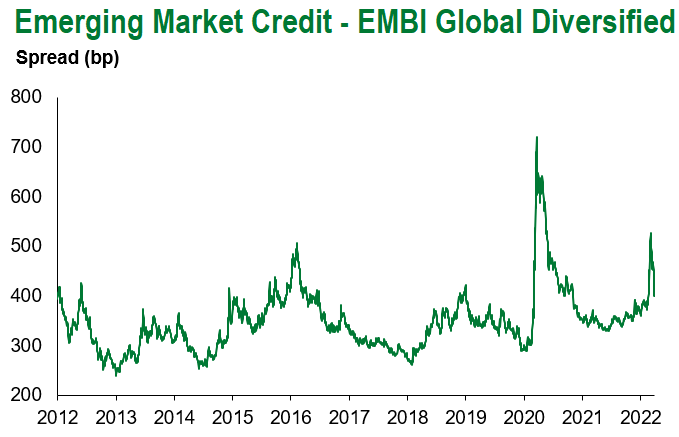
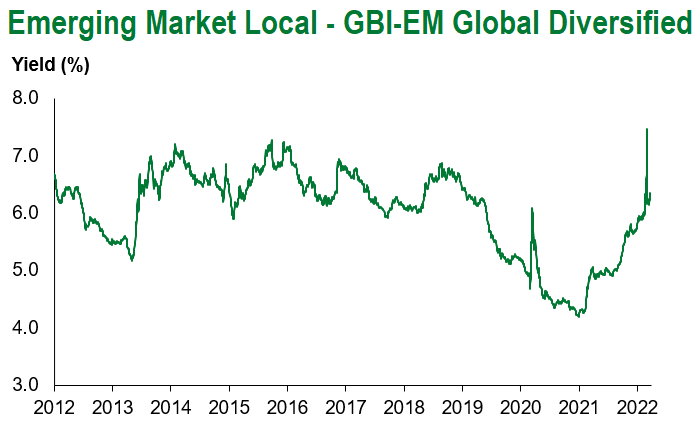
Emerging Markets Technicals
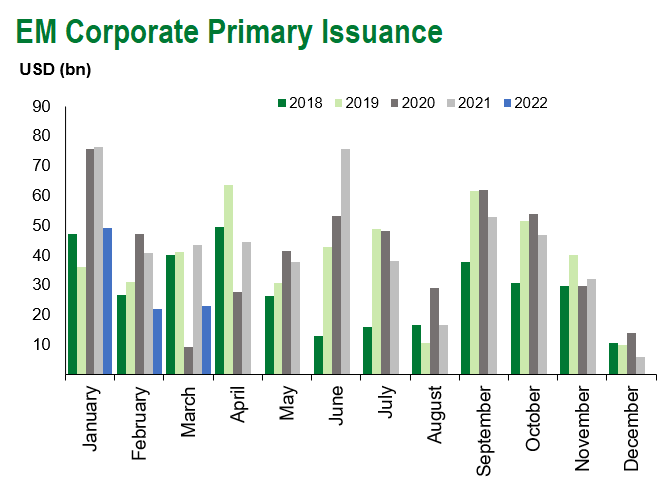
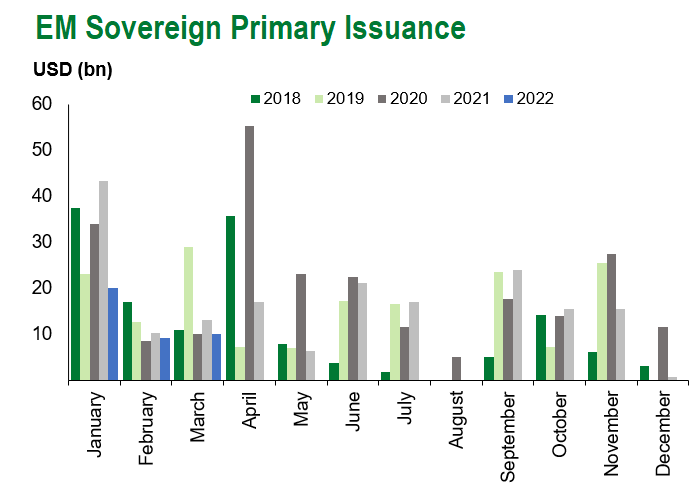
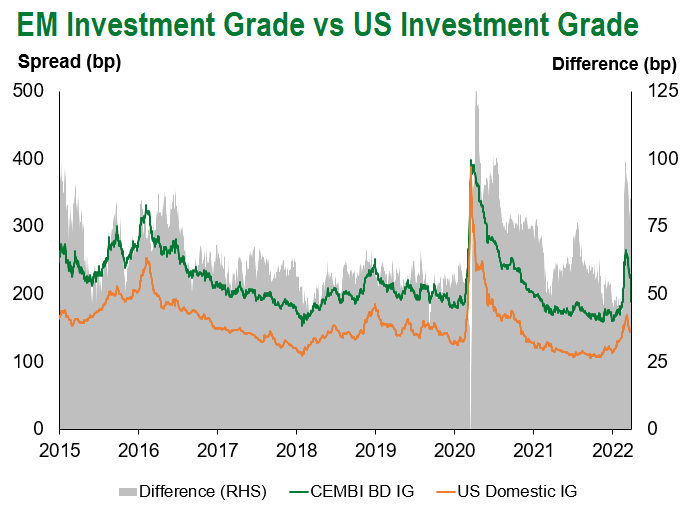
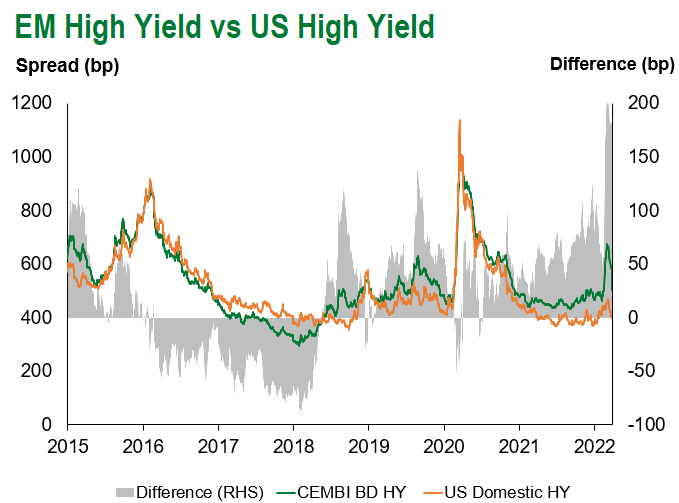
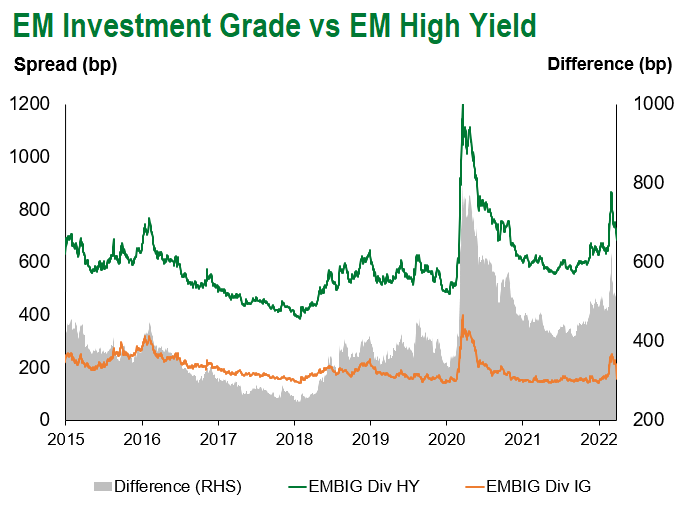
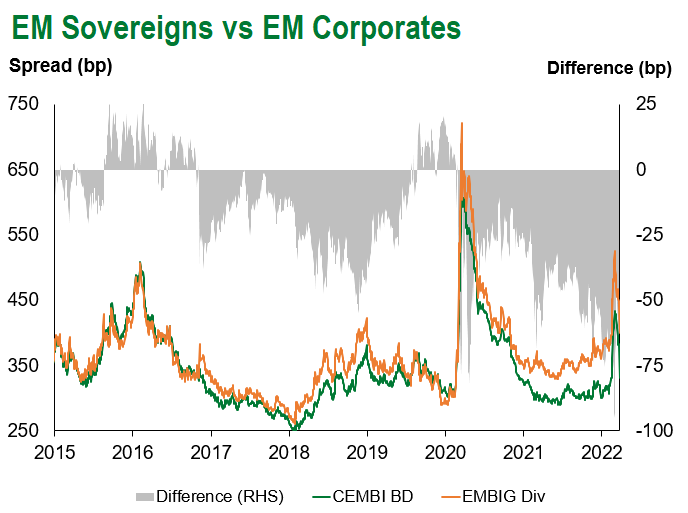
Emerging Markets Flows
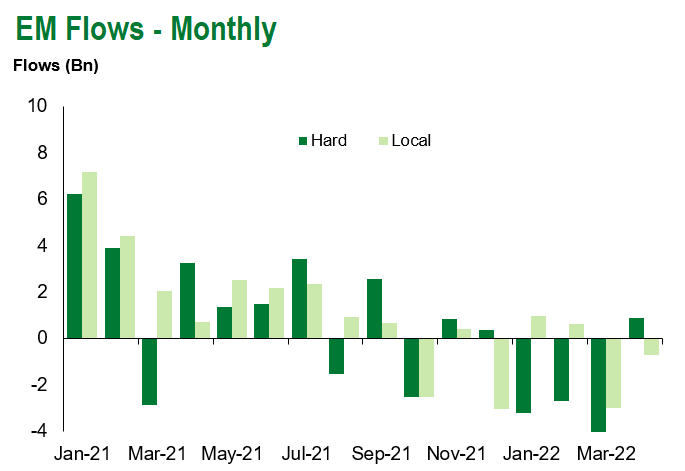
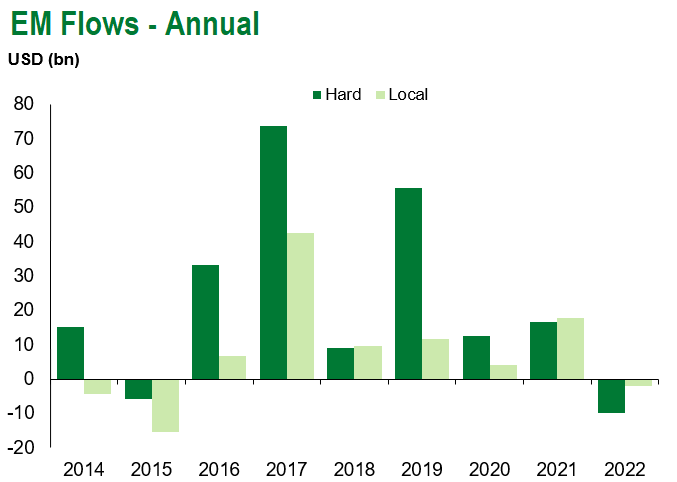
Source for graphs: Bloomberg, JPMorgan, Gramercy. As of April 1, 2022.
COVID Resources
Emerging Markets COVID-19 Case Summary
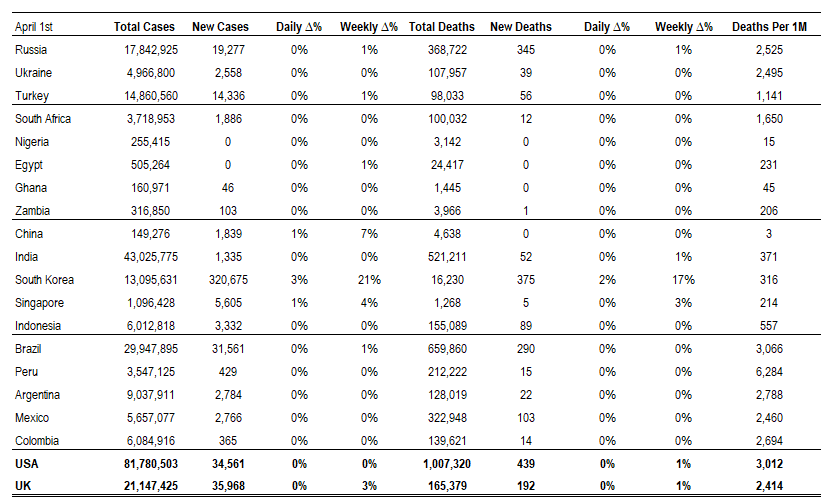
Source: Worldometer as of April 1, 2022.
Additional Crisis Resources:
Johns Hopkins COVID-19 Case Tracker
For questions, please contact:
Kathryn Exum, CFA ESG, Director, Co-Head of Sovereign Research, [email protected]
Petar Atanasov, Director, Co-Head of Sovereign Research, [email protected]
Tolu Alamutu, CFA, Director, Corporate Research Analyst, [email protected]
James Barry, Vice President, Corporate Research Analyst, [email protected]
This document is for informational purposes only. The information presented is not intended to be relied upon as a forecast, research or investment advice, and is not a recommendation, offer or solicitation to buy or sell any securities or to adopt any investment strategy. Gramercy may have current investment positions in the securities or sovereigns mentioned above. The information and opinions contained in this paper are as of the date of initial publication, derived from proprietary and nonproprietary sources deemed by Gramercy to be reliable, are not necessarily all-inclusive and are not guaranteed as to accuracy. This paper may contain “forward-looking” information that is not purely historical in nature. Such information may include, among other things, projections and forecasts. There is no guarantee that any forecasts made will come to pass. Reliance upon information in this paper is at the sole discretion of the reader. You should not rely on this presentation as the basis upon which to make an investment decision. Investment involves risk. There can be no assurance that investment objectives will be achieved. Investors must be prepared to bear the risk of a total loss of their investment. These risks are often heightened for investments in emerging/developing markets or smaller capital markets. International investing involves risks, including risks related to foreign currency, limited liquidity, less government regulation, and the possibility of substantial volatility due to adverse political, economic or other developments. The information provided herein is neither tax nor legal advice. Investors should speak to their tax professional for specific information regarding their tax situation.